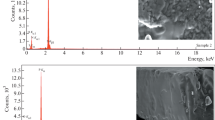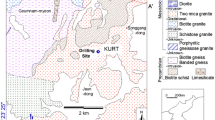Abstract
The contribution of di-ammonium phosphate (DAP) fertilizers to groundwater uranium contamination was investigated using the wavelength dispersive X-ray fluorescence technique and direct measurement of emitted γ-ray energy from primordial radionuclide present in the collected fertilizer samples. The role of fertilizers in uranium poisoning of groundwater has been studied for the first time. DAP fertilizer samples were gathered from Chandigarh and other places in Punjab state, India. About 30% of the DAP fertilizer samples have uranium concentrations between 100 and 200 ppm, whereas the rest have a low uranium content (less than 50 ppm). The strength of the 63.3 keV γ-ray signal produced by the decay of 234Th was also used to assess the uranium concentration in DAP samples. Furthermore, the impact of uranium poisoning of groundwater via fertilizers has been determined to have a substantial role in the water-logged region.





Similar content being viewed by others
References
Mehra R, Singh S, Singh K (2007) Uranium studies in water samples belonging to Malwa region of Punjab, using track etching technique. Radiat Meas 42:441–445. https://doi.org/10.1016/j.radmeas.2007.01.040
Singh J, Singh H, Singh S, Bajwa BS (2008) Estimation of uranium and radon concentration in some drinking water samples. Radiat Meas 43:S523–S526. https://doi.org/10.1016/j.radmeas.2008.04.004
Kumar M, Prasher S, Singh S (2009) Uranium analysis in some food samples collected from Bathinda area of Punjab, India. Indian J Phys 83:1045–1050. https://doi.org/10.1007/s12648-009-0066-3
Singh H, Singh J, Singh S, Bajwa BS (2009) Uranium concentration in drinking water samples using the SSNTDs. Indian J Phys 83:1039–1044. https://doi.org/10.1007/s12648-009-0065-4
Kochhar N, Gill GS, Tuli N, Dadwal V, Balaram V (2007) Chemical quality of ground water in relation to incidence of cancer in parts of SW Punjab, India. Asian J Water Environ Pollut 4:107–112
Farooq SH, Chandrasekharam D, Berner Z, Norra S, Stüben D (2010) Influence of traditional agricultural practices on mobilization of arsenic from sediments to groundwater in Bengal delta. Water Res 44:5575–5588. https://doi.org/10.1016/j.watres.2010.05.057
Reza AS, Jean JS, Lee MK, Liu CC, Bundschuh J, Yang HJ, Lee JF, Lee YC (2010) Implications of organic matter on arsenic mobilization into groundwater: evidence from northwestern (Chapai-Nawabganj), central (Manikganj) and southeastern (Chandpur) Bangladesh. Water Res 44:5556–5574. https://doi.org/10.1016/j.watres.2010.09.004
Riedel T, Kübeck C (2018) Uranium in groundwater–a synopsis based on a large hydrogeochemical data set. Water Res 129:29–38. https://doi.org/10.1016/j.watres.2017.11.001
Schroder JJ, Cordell D, Smit AL, Rosemarin A (2010) Sustainable use of phosphorus: EU tender ENV. B1/ETU/2009/0025 (No. 357). Plant Research International
Alam MN, Chowdhury MI, Kamal M, Ghose S, Mahmmod N, Matin AK, Saikat SQ (1997) Radioactivity in sediments of the Karnaphuli river estuary and the Bay of Bengal. Health Phys 73:385–387. https://doi.org/10.1097/00004032-199708000-00013
Karahan G, Bayulken A (2000) Assessment of gamma dose rates around Istanbul (Turkey). J Environ Radioact 47:213–221. https://doi.org/10.1016/S0265-931X(99)00034-X
El Arabi AM (2005) Gamma activity in some environmental samples in south Egypt
Papaefthymiou H, Papatheodorou G, Moustakli A, Christodoulou D, Geraga M (2007) Natural radionuclides and 137Cs distributions and their relationship with sedimentological processes in Patras Harbour, Greece. J Environ Radioact 94:55–74. https://doi.org/10.1016/j.jenvrad.2006.12.014
Papachristodoulou CA, Assimakopoulos PA, Patronis NE, Ioannides KG (2003) Use of HPGe γ-ray spectrometry to assess the isotopic compositiion of uranium in soils. J Environ Radioact 64:195–203. https://doi.org/10.1016/S0265-931X(02)00049-8
Browne E, Tuli JK (2007) Nuclear data sheets for A= 234. Nucl Data Sheets 108:681–772. https://doi.org/10.1016/j.nds.2007.02.003
Kainth HS, Upmanyu A, Sharma H, Singh T, Kumar S (2018) Chemical state analysis of Cl Kα and Kβ1, 3 X-ray emission lines using polychromatic WDXRF spectrometer. Nucl Instrum Methods Phys Res B 416:62–67. https://doi.org/10.1016/j.nimb.2017.12.011
Kainth HS, Singh T (2019) Chemical effects in K emission spectra of 38Sr compounds. Radiat Phys Chem 158:209–217. https://doi.org/10.1016/j.radphyschem.2019.01.020
Rousseau RM (2009) The quest for a fundamental algorithm in X-ray fluorescence analysis and calibration. Open Spectrosc J 3:31–42. https://doi.org/10.2174/1874383800903010031
Kainth HS (2018) Study of detection limit and sensitivity of K α and L α spectral lines of 47Ag, 48Cd, and 50Sn elements using polychromatic wavelength dispersive X-ray spectrometer. X-ray Spectrom 47:382–387. https://doi.org/10.1002/xrs.2954
Singh R, Kainth HS, Prasher P, Singh T (2018) Trace elemental analysis of human breast cancerous blood by advanced PC-WDXRF technique. Nucl Instrum Methods Phys Res B 419:44–48. https://doi.org/10.1016/j.nimb.2018.01.029
Kainth HS, Khandelwal D (2020) Evaluation of chemical speciation on L p (p= l, α, η, β) X-ray emission peaks of thallium compounds with a wavelength-dispersive spectrometer. J Anal Atomic Spectrom 35:2935–2947. https://doi.org/10.1039/D0JA00379D
Barišić D, Lulić S, Miletić P (1992) Radium and uranium in phosphate fertilizers and their impact on the radioactivity of waters. Water Res 26:607–611. https://doi.org/10.1016/0043-1354(92)90234-U
Yamazaki IM, Geraldo LP (2003) Uranium content in phosphate fertilizers commercially produced in Brazil. Appl Radiat Isotopes 59:133–136. https://doi.org/10.1016/S0969-8043(03)00159-3
Misra NL, Dhara S, Das A, Lodha GS, Aggarwal SK, Varga I (2011) Trace determination of uranium in fertilizer samples by total reflection X-ray fluorescence. Pramana 76:357–360. https://doi.org/10.1007/s12043-011-0034-2
Vogel C, Hoffmann MC, Taube MC, Krüger O, Baran R, Adam C (2020) Uranium and thorium species in phosphate rock and sewage sludge ash based phosphorus fertilizers. J Hazard Mater 382:121100. https://doi.org/10.1016/j.jhazmat.2019.121100
Tulsidas H, Gabriel S, Kiegiel K, Haneklaus N (2019) Uranium resources in EU phosphate rock imports. Resour Policy 61:151–156. https://doi.org/10.1016/j.resourpol.2019.02.012
Lyons WB, Gardner CB, Welch SA, Israel S (2020) Uranium in Ohio, USA surface waters: implications for a fertilizer source in waters draining agricultural lands. Sci Rep 10:1–6. https://doi.org/10.1038/s41598-020-61922-2
Bjørklund G, Semenova Y, Pivina L, Dadar M, Rahman M, Aaseth J, Chirumbolo S (2020) Uranium in drinking water: a public health threat. Arch Toxicol 94:1551–1560. https://doi.org/10.1007/s00204-020-02676-8
Sun Y, Wu B, Amelung W, Christensen BT, Pätzold S, Bauke SL, Schweitzer K, Baumecker M, Bol R (2020) Non-critical uranium accumulation in soils of German and Danish long-term fertilizer experiments. Geoderma 370:114336. https://doi.org/10.1016/j.geoderma.2020.114336
Use of fertilizers in India. https://economictimes.indiatimes.com/news/economy/agriculture/fertiliser-use-on-the-rise-in-india-soil-health-deteriorating/articleshow/7760785.cms?from=mdr. Accessed 8 Feb 2022
Pant D, Keesari T, Sharma D, Rishi M, Singh G, Jaryal A, Sinha UK, Dash A, Tripathi RM (2017) Study on uranium contamination in groundwater of Faridkot and Muktsar districts of Punjab using stable isotopes of water. J Radioanal Nucl Chem 313:635–639. https://doi.org/10.1007/s10967-017-5284-0
Srivastava A, Bains GS, Acharya R, Reddy AVR (2011) Study of seleniferous soils using instrumental neutron activation analysis. Appl Radiat Isotopes 69:818–821
Acknowledgements
The financial help provided to Dr. Harpreet Singh Kainth under the DS Kothari contract [F.4-2/2006 (BSR)/PH/18-19/0084] is highly regarded. Dr. Gurjeet Singh is grateful for the financial support he received from the Science and Engineering Research Board (SERB) of the Department of Science and Technology (DST) New Delhi, grant number YSS/2015/001862 in the form of the Young Scientist Award (YST).
Author information
Authors and Affiliations
Corresponding author
Additional information
Publisher's Note
Springer Nature remains neutral with regard to jurisdictional claims in published maps and institutional affiliations.
Rights and permissions
About this article
Cite this article
Singh, G., Kainth, H.S., Singh, G. et al. Measurement of uranium in phosphate fertilizers for groundwater contamination employing X-ray and γ-ray spectroscopic techniques. J Radioanal Nucl Chem 331, 1715–1722 (2022). https://doi.org/10.1007/s10967-022-08269-2
Received:
Accepted:
Published:
Issue Date:
DOI: https://doi.org/10.1007/s10967-022-08269-2




